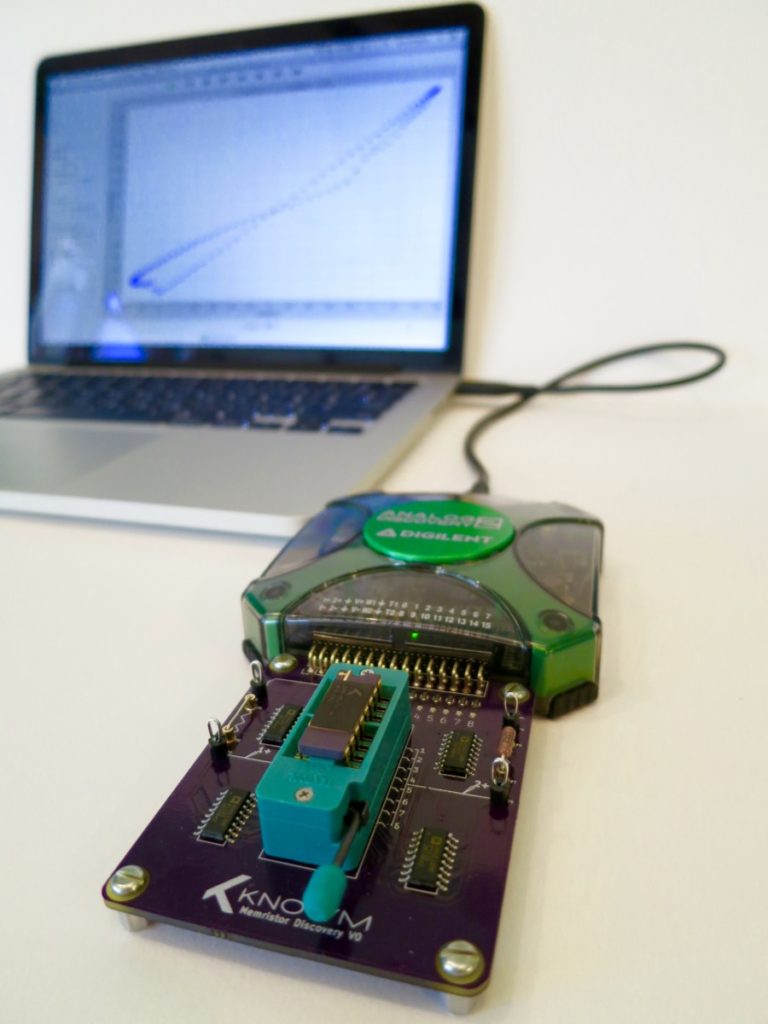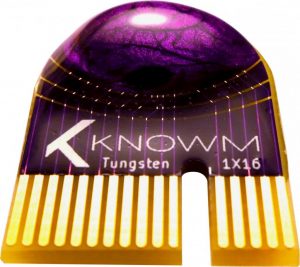A Big Need For Something Simple
Reliable and robust CMOS compatible memristors exist and they are going to change the world of computing and electronics. Before this can happen, however, we must separate fantasy from fact and we all must learn how to use them. This is not as easy as it sounds, as the very fabric of electronic design has evolved for a century without inclusion of the memristor. Some of the basic functions needed to properly support memristor simulation, for example random number generators, are not even included in many circuit modeling packages! Before circuit designers can design circuits with memristors they have to understand them. Before they can understand them, they must get hands-on experience. Dare we say play with them.

Memristor Discovery PCB from PCB prototyping service OSH Park
We have now sold memristors to clients all over the world. Some have found quick applications. Others are left scratching their head as what they see is not exactly what they expect, sometimes failing to account for equipment measurement noise or voltage transients. A simple question like “why does the memristor not increment” could have many answers. Is it saturated? Did you form the device? Did you kill it with voltage transients or by using a multi-meter to measure the resistance? How many times has it been cycled? What is your measurement equipment setup? The questions keep coming, and they teach us a lesson. A memristor’s state is dependent on its entire prior history. The measurement is dependent on your setup. With all this variability, it sure would be nice to have a common platform to conduct memristor experiments. A platform where we could all get on the same page, sharing our own code and experience, and evolve together into the future.
Many professors have expressed interest to us in teaching a memristor course but need a platform that prevents common routes to memristor damage, such as over current and high voltages. Most classes cannot afford the $75,000 semiconductor parameter analyzers and $20,000 wafer probe stations used by professionals like Dr. Campbell, so affordability is critical.

Memristor Discovery with Cross-platform Software
Memristor Discovery
This is why we created the Memristor Discovery board. We searched the new market of pocket oscilloscopes and signal generators for an all-in-one platform that we could extend to help teach memristor science. We found it with the Diligent Analog Discovery 2 (AD2), an affordable ‘all in one’ multi-function instrument that allows users to measure, visualize, generate, record, and control mixed signal circuits. The AD2 was designed for students in a typical university-based circuits and electronics class. It’s features and specifications were obtained from feedback from professors at many universities and include USB control and power, small and portable form factor, robustness to withstand student abuse, and low-cost. The included Waveforms software is impressive and extremely easy to use. Memristor Discovery plugs into the Analog Discovery 2. Digital IO channels 0-7 activate analog switches that couple memristors to the AD2 waveform generator and two oscilloscopes. On LEDs indicate closed switches. Easy access test-points and pin sockets allow for coupling of the circuit to additional measurement equipment and bread-boards. A lever-actuated DIP socket provides zero insertion force to prevent handling damage of chip pins.
Memristor Discovery software is open-source and available at https://github.com/knowm/memristor-discovery.
















2 Comments
juan-luis del valle
It is good to have an experimental system to characterize memristors as a Knowm Memristor Discovery board for introduce our students to the field of memristors.
Besides we are looking for an experimental tool that allow us to explore simple neuromophic circuits (micronetworks) for learning and memory experiments like associative memory (Pavlov), Aplysia and amoeba, that require neurons.¿ Are you planning to emulate device capable to produce action potentials?
Nigel Jarvis
I like the combination of your ‘chip’ with AD2 but I have been using the ADALM1000 from Analog Devices which uses either the PixelPulse or Alice opensource software. Would I be able to connect the chip to this SMU?